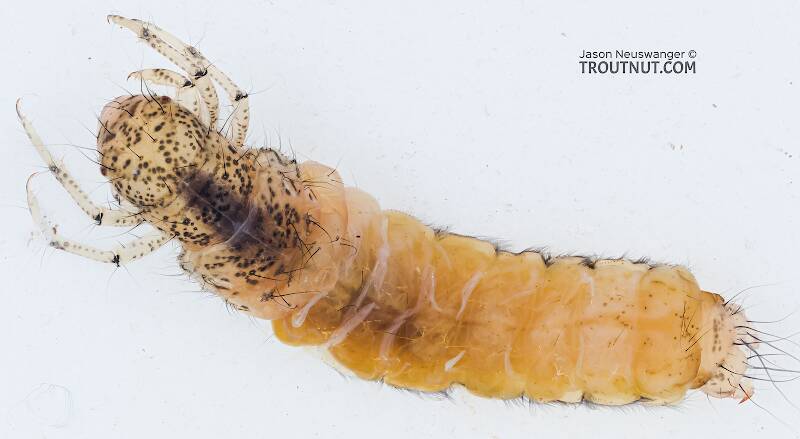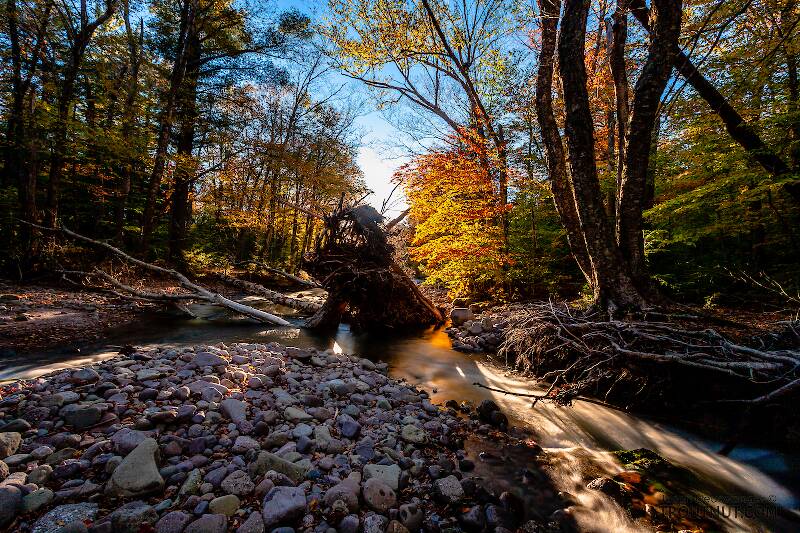
Salmonflies
Pteronarcys californica
The giant Salmonflies of the Western mountains are legendary for their proclivity to elicit consistent dry-fly action and ferocious strikes.
Featured on the forum

This is a striking caddis larva with an interesting color pattern on the head. Here are some characteristics I was able to see under the microscope, but could not easily expose for a picture:
- The prosternal horn is present.
- The mandible is clearly toothed, not formed into a uniform scraper blade.
- The seems to be only 2 major setae on the ventral edge of the hind femur.
- Chloride epithelia seem to be absent from the dorsal side of any abdominal segments.
Based on these characteristics and the ones more easily visible from the pictures, this seems to be Grammotaulius. The key's description of the case is spot-on: "Case cylindrical, made of longitudinally arranged sedge or similar leaves," as is the description of the markings on the head, "Dorsum of head light brownish yellow with numerous discrete, small, dark spots." The spot pattern on the head is a very good match to figure 19.312 of Merritt R.W., Cummins, K.W., and Berg, M.B. (2019). The species ID is based on Grammotaulius betteni being the only species of this genus known in Washington state.
- The prosternal horn is present.
- The mandible is clearly toothed, not formed into a uniform scraper blade.
- The seems to be only 2 major setae on the ventral edge of the hind femur.
- Chloride epithelia seem to be absent from the dorsal side of any abdominal segments.
Based on these characteristics and the ones more easily visible from the pictures, this seems to be Grammotaulius. The key's description of the case is spot-on: "Case cylindrical, made of longitudinally arranged sedge or similar leaves," as is the description of the markings on the head, "Dorsum of head light brownish yellow with numerous discrete, small, dark spots." The spot pattern on the head is a very good match to figure 19.312 of Merritt R.W., Cummins, K.W., and Berg, M.B. (2019). The species ID is based on Grammotaulius betteni being the only species of this genus known in Washington state.

Troutnut is a project started in 2003 by salmonid ecologist Jason "Troutnut" Neuswanger to help anglers and
fly tyers unabashedly embrace the entomological side of the sport. Learn more about Troutnut or
support the project for an enhanced experience here.
Entoman on Dec 3, 2011December 3rd, 2011, 12:56 am EST
Another gizmo!?! Are you trying to end up like me? Bent over like Quasimoto?! :)
Na... I sold it to a bass pro for 50 cents on the $. He acted like I sold him the philosopher stone.:) - Gollum jumping around with the ring.
Besides, we've talked about this before, I'm a minimalist on the stream. I don't worry about being bent over. Now tripping over all the crap in the boat and taking a bath is another matter.:)
"It's not that I find fishing so important, it's just that I find all other endeavors of Man equally unimportant... And not nearly as much fun!" Robert Traver, Anatomy of a Fisherman
Gutcutter on Dec 3, 2011December 3rd, 2011, 3:43 am EST
Fish can see color, and there's one very simple way to prove it without any experiments:
Fish ARE colorful!
If they couldn't see color, why would they change colors when the breeding season approaches? Or be different colors, so they can recognize members of their own species?
So, I guess Maples and Aspens can see color and Douglas-fir can not?
Now, white-tailed deer can NOT see color (which is why you can wear hunter orange and still not be spotted by them)
Deer see movement and contrast, and a solid "blob" of any color whether it be hunter orange, red, or white is detected, and conversely, a moving camo clad human is easily detected, too.
but then again, they're not colorful animals, rather being shades of brown, grey, and white...
Maybe the Odocoileus virginianus don't change color in your neck of the woods, but they sure do around here.
Spotted fawns to a red spring coat to a light tan summer coat to a dark brown during the rut then an almost black in the winter.
All men who fish may in turn be divided into two parts: those who fish for trout and those who don't. Trout fishermen are a race apart: they are a dedicated crew- indolent, improvident, and quietly mad.
-Robert Traver, Trout Madness
-Robert Traver, Trout Madness
Falsifly on Dec 3, 2011December 3rd, 2011, 8:30 am EST
Now, white-tailed deer can NOT see color
There is plenty of scientific evidence that suggests that deer can see color. Although they are color blind on the longer wavelength end of the spectrum and see it as gray this is not true on the shorter end.
Falsifly
When asked what I just caught that monster on I showed him. He put on his magnifiers and said, "I can't believe they can see that."
When asked what I just caught that monster on I showed him. He put on his magnifiers and said, "I can't believe they can see that."
Entoman on Dec 3, 2011December 3rd, 2011, 11:18 am EST
Any animal with eyes that contain rods can perceive color, at least to some extent.
Not entirely correct, Tony. While it's true that maples and aspens can perceive colors across a broader spectrum, doug firs see green very well.
That is my understanding as well, Allan. The bright orange and red camos that protect hunters from other sharp-shooters (in theory) supposedly blend right in. Since ungulates also see into the ultra-violet range a little, phosphate soaps are supposed to be the big problem with concealment. Like freshly laundered denim under a black light? IMHO, nothing beats wool in the woods. Odor suppression, range of comfort, UV absorption, sound suppression, warm even when wet... The old guys had it right.
So, I guess Maples and Aspens can see color and Douglass fir can not?
Not entirely correct, Tony. While it's true that maples and aspens can perceive colors across a broader spectrum, doug firs see green very well.
There is plenty of scientific evidence that suggests that deer can see color. Although they are color blind on the longer wavelength end of the spectrum and see it as gray this is not true on the shorter end.
That is my understanding as well, Allan. The bright orange and red camos that protect hunters from other sharp-shooters (in theory) supposedly blend right in. Since ungulates also see into the ultra-violet range a little, phosphate soaps are supposed to be the big problem with concealment. Like freshly laundered denim under a black light? IMHO, nothing beats wool in the woods. Odor suppression, range of comfort, UV absorption, sound suppression, warm even when wet... The old guys had it right.
"It's not that I find fishing so important, it's just that I find all other endeavors of Man equally unimportant... And not nearly as much fun!" Robert Traver, Anatomy of a Fisherman
Jmd123 on Dec 3, 2011December 3rd, 2011, 12:00 pm EST
Uh, Tony, well, let's see here...
First of all, aspens, maples, douglas-firs, and other trees (and plants as well) DON'T HAVE EYES. I have a degree in botany so I'm pretty certain of this...and they also do not rely on colors for mate recognition, nor do they rely on brightness and intensity of colors to determine the health, vigor, and genetic suitability of mates. Your examples are in fact WIND POLLINATED, although some insects have been known to visit maple flowers of some species.
And yes, our deer here in Michigan are various shades of grey, brown, and white. Fawns may be a richer brown, but they're not concerned about mating, rather hiding from predators like coyotes, bears, bobcats, cougars (yep, we got 'em, despite what the MDNR says), etc...Also, I have seen deer hunters here in my state use bright yellow or chartruese colors when hunting. Deer key on MOVEMENT, sound, and scent, NOT color.
If you really think I'm full of it, as you typically do in your contrarian fashion to nearly all of my posts, I would like YOU to explain why fish are colorful and how it does or does not influence whether or not fish can see colors. Please. I stand by my argument.
Jonathon
First of all, aspens, maples, douglas-firs, and other trees (and plants as well) DON'T HAVE EYES. I have a degree in botany so I'm pretty certain of this...and they also do not rely on colors for mate recognition, nor do they rely on brightness and intensity of colors to determine the health, vigor, and genetic suitability of mates. Your examples are in fact WIND POLLINATED, although some insects have been known to visit maple flowers of some species.
And yes, our deer here in Michigan are various shades of grey, brown, and white. Fawns may be a richer brown, but they're not concerned about mating, rather hiding from predators like coyotes, bears, bobcats, cougars (yep, we got 'em, despite what the MDNR says), etc...Also, I have seen deer hunters here in my state use bright yellow or chartruese colors when hunting. Deer key on MOVEMENT, sound, and scent, NOT color.
If you really think I'm full of it, as you typically do in your contrarian fashion to nearly all of my posts, I would like YOU to explain why fish are colorful and how it does or does not influence whether or not fish can see colors. Please. I stand by my argument.
Jonathon
No matter how big the one you just caught is, there's always a bigger one out there somewhere...
Sayfu
Posts: 560
Posts: 560
Sayfu on Dec 4, 2011December 4th, 2011, 4:24 am EST
Haven't read all of these posts, but, bugs/nymphs that reside in the weeds often take on the color of the vegetation..olive scuds for example. Fish often at least are white on the belly, and darker on the top for those viewing them either from above so they blend into the bottom, or for those looking up at them, and blending into the sky. I would tell clients when we'd pass through the shallower tailouts where we could see the bottom when they would yell out, "there's one!"..and I would tell them it was probably a white fish, or a sucker, as they roll a lot feeding on nymphs, and you get the chance to see their white bellies. I would stand for long periods of time on a low bridge just below where steelhead entered a hatchery, and when the main river turned brown, and high after a rain. Steelhead would move into this little feeder creek that had clear water, and then enter the hatchery.(Dec.-Jan) Fisherman would line the banks allowed to fish in the feeder stream, and those of us on the bridge would stare hard looking over every rock to pick out a steelhead laying next to it. Hard to do, and it was like picking out an object hidden wikthin the picture, because these trout would blend into the bottom so well.
Quick Reply
Related Discussions
Topic
Replies
Last Reply
1
Aug 21, 2007
by Gene
by Gene
Five days of warmwater flyfishing in southeastern Michigan - from Jonathon
In Fishing Reports by Jmd123
In Fishing Reports by Jmd123
0
Jul 22, 2009
by Jmd123
by Jmd123
Re: Identification of a possible Cordulegaster Dragonfly Nymph
In Cordulegaster Dragonfly Nymph by IanB
In Cordulegaster Dragonfly Nymph by IanB
6
Feb 10, 2017
by Taxon
by Taxon





